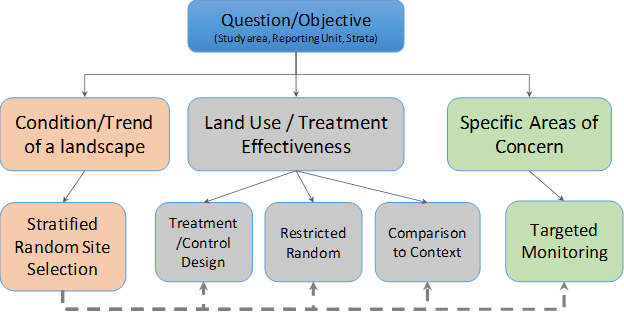
Assessment, Inventory, and Monitoring (AIM)
The Assessment, Inventory, and Monitoring (AIM) Strategy provides a set of standards for assessing natural resource conditions and trends on BLM-managed public lands. The AIM Strategy provides quantitative data and tools to guide and justify policy actions, land uses and adaptive management decisions.
AIM is…
- Structured implementation
Guides monitoring program development, implementation, and data use for decision makers. AIM monitoring starts with identifying clear management questions to inform when, where, and how often to collect data. This and all other steps of AIM implementation are supported by a network of subject matter experts including State Leads, Monitoring Coordinators, and the BLM National Operations Center. Collectively, the AIM Team provides practitioner support with:
- Contracting support for field crew hiring and other services
- Monitoring plan development
- Identification and implementation of appropriate sample designs
- Field methods training
- Data collection, storage, and access solutions
- Data quality assurance and control procedures
- Analysis and reporting tools and support
- Standardized Field Measurements
Allows data comparisons through space and time in support of multiple management decisions. AIM field methods were developed by a network of BLM experts and partners. The objectives were to ensure usable and defensible data for the BLM, while also standardizing monitoring efforts across agencies and jurisdictions. These dual objectives were achieved by adopting field methods used and tested by multiple agencies and partners throughout the western U.S. and Alaska.
Terrestrial – Designed for upland habitats, the terrestrial methods provide comprehensive information on rangeland vegetative and soil conditions.
- Example indicators derived from field methods: bare ground, vegetation composition, vegetation height, canopy gap, distribution of nonnative/invasive plant species.
- Citation: Monitoring Manual for Grassland, Shrubland and Savanna Ecosystems Volume 1
Lotic – Designed to provide quantitative data for wadable streams and rivers on all BLM lands.
- Example indicators derived from field methods: conductivity, temperature, pool frequency, % fine sediment in streambed substrates, bank stability and cover, floodplain connectivity, macroinvertebrate biological condition.
- Citation: BLM AIM National Aquatic Monitoring Framework: Field Protocol for Wadeable Lotic Systems
Riparian and Wetland – Designed for riparian areas, floodplains, and wetlands, the Riparian and Wetland data bridge the information gap between terrestrial and lotic areas.
- Example indicators derived from field methods: Bare ground, vegetation composition, soil characterization, vegetation height, water source, pH, conductivity.
- Citation: BLM AIM National Aquatic Monitoring Framework: Field Protocol for Lentic Riparian and Wetland Systems
- Appropriate Sample Designs
Minimizes bias and maximize inference of collected data. BLM is actively using the AIM Strategy to inform management decisions at multiple spatial scales from individual restoration projects on up to national level reporting. The AIM Team at the BLM’s National Operations Center provides technical support for the development of appropriate sample designs to match monitoring objectives from targeted sampling to spatially balanced, random sampling.
- Data Management and Stewardship
Ensures data quality, accessibility, and use. AIM data are collected using mobile applications, stored in a centralized BLM repository and available to users via web portals and spatial data services. Mobile applications allow for greater integration of QA & QC practices while also making data available quickly. Centralized data storage gives users the ability to analyze AIM data independently or with developed tools supplied by the program.
View and access AIM data
External: https://www.blm.gov/AIM/PublicData
Internal: https://www.blm.gov/AIM/AIMDataPortal- Integration with Remote Sensing
Optimizes sampling and calibrate continuous map products. Remote sensing datasets are another way that AIM data informs land management decision-making. For example, LANDFIRE products map vegetation types and many fire-related landscape attributes. Fractional vegetation cover maps are increasingly available as well, including RAP, LandCART, RCMAP Viewer, Near-Real-Time Cheatgrass, and more. Practical advice for applying these products in decision-making is available from Allred et al. 2020 and BLM TN456.
Rapid advancement of remote sensing technology combined with on the ground AIM data provides land managers with tools related to:
- Bird’s eye view of vegetation cover
- Landscape trend analyses and monitoring
- Sagebrush availability for sage grouse habitat mapping
- Treatment effectiveness modeling
- Remapping efforts of nationwide landscape datasets
- Standard Workflows and Analysis Frameworks for Using Data
Standard workflows empower land managers to make defensible decisions regarding multiple uses of rangeland ecosystems sustained through time. Ideally, workflows consider the full suite of standard datasets that support decision-making, including supplemental indicators, permitted uses, and natural disturbances. They also foster co-production of knowledge by integrating multiple knowledge types. Workflows have been developed for land health and wildlife habitat evaluations and more.
Example management questions addressed by AIM:
- Are management areas attaining BLM Land Health Standards?
- What is the distribution of invasive species and where can prioritization of treatment areas occur?
- What is the effectiveness of reclamation or restoration treatments?
- Are we maintaining or improving habitat conditions for species of management concern (e.g., greater sage-grouse, native fishes, and mule deer habitat)?
- What is the effectiveness of land use plans?
- What is the existing condition and trend of resources that may be affected by a proposed action?
- Is BLM meeting performance measures outlined in the Department of the Interior Strategic Plan?
| AIM Fact Sheet | Introduction to AIM |
|---|---|


